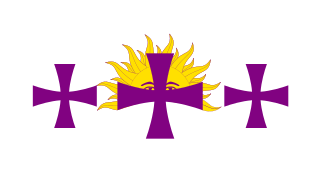Related Research Articles

Peruvian coastal Spanish, also known as Ribereño Spanish or Spanish from Lima, is the form of the Spanish language spoken in the coastal region of Peru. The dialect has four characteristic forms today: the original one, that of the inhabitants of Lima near the Pacific coast and partially to the south ; the inland immigrant sociolect ; the Northern form, in Trujillo, Chiclayo or Piura; and the Southern form. The majority of Peruvians speak this dialect, as it is the standard dialect of Spanish in Peru.

Colombians are people identified with the country of Colombia. This connection may be residential, legal, historical or cultural. For most Colombians, several of these connections exist and are collectively the source of their being Colombian.

Hispanidad is a Spanish term describing a shared cultural, linguistic, or political identity among speakers of the Spanish language or members of the Hispanic diaspora. The term can have various, different implications and meanings depending on the regional, socio-political, or cultural context in which it is used.

Immigration to Spain increased significantly in the beginning of the 21st century. In 1998, immigrants accounted for 1.6% of the population, and by 2009, that number had risen to over 12%. Until 2014, the numbers were decreasing due to the economic crisis, but since 2015, immigration to Spain has increased again, especially after 2021.

Francisco Moreno-Fernández is a Spanish dialectologist and sociolinguist.
Moroccans in Spain formed 16.4% of the 4,549,858 foreigners in Spain as of 1 January 2017. They are again the largest foreign group in Spain, after they were surpassed temporarily by Romanians in 2007. In 2003, they were estimated to make up about 6% of all Moroccans abroad. In 2022 the number of Moroccans increase to 1,000,000.
Alberto Augusto Valdivia Baselli is a Peruvian poet, writer, essayist, literary scholar, and specialist in Peruvian and Latin American Philosophy and culture.

Carlos Yushimito del Valle is a Peruvian writer of Japanese descent.
Illegal immigration in Chile is a phenomenon that largely began in the 1990s as a result of economic growth and political stability in Chile. Most immigrants are South American, with the largest wave being Peruvian, although there has also been a significant amount of migration from the Caribbean. Illegal immigration is primarily caused by a lack of security or economic opportunities in the country of origin.

Miguel Herrero y Rodríguez de Miñón is a Spanish jurist and politician. A member of the Union of the Democratic Centre until 1982, then of People's Alliance and its successor, the People's Party, he is one of the "Fathers of the Constitution", the seven legislators who participating in the draft of the Spanish constitutional text passed in 1978.

Elvira Travesí was an Argentinean actress.
José María Marco Tobarra is a Spanish essayist and liberal-conservative opinion journalist.
Francisco Gómez Camacho was a Spanish Jesuit priest and academic who was Professor of Economics at the Comillas Pontifical University in Madrid. He died on 5 February 2024, at the age of 84.
As of January 2021, there are 2,480,373 South Americans in Spain and 624,034 Central American or Caribbean people in Spain. Flows of migration have been dependent on the economic conditions in their countries of birth and in Spain.
Racism in Peru comprises negative attitudes and views on race or ethnicity which are related to each other, are held by various people and groups in Peru, and have been reflected in discriminatory laws, practices and actions at various times in the history of Peru against racial or ethnic groups. Peruvian intellectuals, who were mainly white and based in the developed capital city of Lima, historically denied that racism existed in Peru and did not focus on the social issue, often participating in racism themselves. The concentration of wealth amongst elites in Lima through centralismo resulted with a history of systemic racism in Peru, with individuals in Lima basing their discrimination against rural individuals due to race and geographical location.

The Royal Army of Peru, also known as the National Army, was the army organised by the viceroy of Peru, José Fernando de Abascal, to protect the Hispanic Monarchy in the Viceroyalty of Peru—and its surrounding provinces of Charcas, Chile and Quito—of the revolutions that convulsed the Spanish Empire at the beginning of the 19th century. This army was made up of 80% Creoles and indigenous Peruvians.
References
- ↑ "Población por país de nacimiento, comunidades y provincias, sexo y edad (hasta 100 y más)". INE (in Spanish). Retrieved 2021-03-23.
- 1 2 INE 2009
- ↑ "Población peruana en España decreció 23.76 % en solo un año", Diario la República, 2017-04-26
